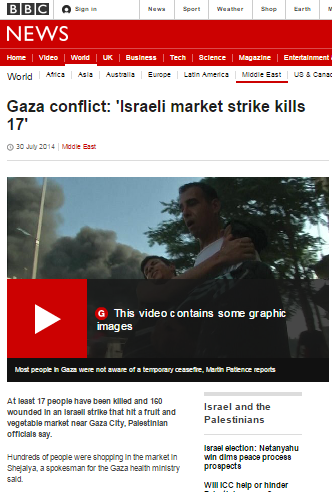On July 30th 2014 the BBC News website published an article (which is still available) titled “Gaza conflict: ‘Israeli market strike kills 17’” in which audiences were told that:
“At least 17 people have been killed and 160 wounded in an Israeli strike that hit a fruit and vegetable market near Gaza City, Palestinian officials say.
Hundreds of people were shopping in the market in Shejaiya, a spokesman for the Gaza health ministry said.
The attack came during a four-hour truce called by the Israeli military. Hamas, which controls Gaza, had rejected the truce as meaningless. […]
Witnesses at the scene of the market strike in Shejaiya spoke of smoke billowing over the site, with ambulances racing victims to hospital.
A journalist who worked for a local news agency was reported to have been killed.
One witness, Salim Qadoum, told Associated Press: “The area now is like a bloodbath, everyone is wounded or killed. People lost their limbs and were screaming for help. It’s a massacre.”
The Palestinian al-Aqsa satellite TV channel quoted Hamas spokesman Fawzi Barhum as saying that the market attack required “an earth-shattering response”.
The Israeli military had said the ceasefire would last between 15:00 (12:00 GMT) and 19:00.
However, it had warned that the truce would only apply to areas where Israeli soldiers were not currently operating, and it told residents not to return to areas they had previously been asked to evacuate.”
On the same day, Martin Patience produced a filmed report on the same incident for BBC television news which still appears on the corporation’s website under the title “Gaza conflict: ‘Israeli market strike kills 15’“. Like the written report, Patience’s account tells of civilians attacked by “an Israeli airstrike” and he informs viewers that:
“…it’s difficult to know which areas were actually covered by this partial ceasefire….but what areas are covered, I don’t think most Palestinians know.”
That incident is one of several which appear in the latest report from the Military Attorney General. Investigation into the incident shows that the BBC’s rapid and unquestioning repetition of Hamas officials’ tales of an out-of-the-blue Israeli airstrike on civilians during a cease-fire breached editorial guidelines on both accuracy and impartiality.
“In reports published in various media sources, it was alleged that on 30 July 2014, IDF forces fired upon the marketplace in Shuja’iyya, at a time when a ceasefire was in place, and as a result of these strikes, between 15 to 17 people were killed, including children, emergency services personnel, and reporters. Subsequently, and in accordance with the MAG’s investigation policy, the incident was referred to the FFA Mechanism for examination. […]
According to the factual findings collated by the FFA Mechanism and presented to the MAG, the events associated with the incident started at approximately 16:10, when an anti-tank (AT) missile was fired at IDF forces operating in an open area on the outskirts of the Shuja’iyya neighborhood. Immediately after the anti-tank missile was fired, there commenced an intense and ongoing burst of mortar fire, emanating from a built-up area in the neighborhood, targeting the forces. As a result of this fire an IDF soldier was injured and the rest of the soldiers at the scene were placed in real danger. Further, in light of this use of fire, and the situation in which the forces found themselves (including a tank that could not move due to malfunction), the conclusion drawn by the commanders in the field was that this fire could provide cover for an attempt to abduct a soldier. During this episode of mortar fire, five sites in a built-up area were identified as points from which shells had been fired at IDF forces. Nevertheless, IDF forces did not return fire towards the sources of this fire, because of their proximity to “sensitive sites” (in the IDF, “sensitive sites” are civilian sites that receive special protection from attack under the law of armed conflict (such as medical facilities), as well as other civilian sites that warrant special consideration for policy reasons, even when there is no legal obligation (such as schools); such sites are identified in advance by the IDF and integrated into IDF’s operational systems).
At approximately 16:40, when the mortar fire had not yet ceased, IDF forces fired a number of rounds of smoke-screening shells, in order to screen the troops, and frustrate the enemy fire. At approximately 17:00, as the mortar fire upon the troops from the built-up area continued, and in light of the ongoing threat to the lives of the troops, the forces were able to identify two additional sources of fire, from which most of the fire towards them was originating at that time. After it was concluded that one of these points was sufficiently distant from sensitive sites, it was decided to return a limited amount of fire, of five mortar shells, with the aim of suppressing the fire targeted at IDF forces. The IDF fire was carried out using mortars, since there was no available alternative for carrying out the strike, including aerial alternatives, which would allow the necessary operational effect to be achieved. In this context, the possibility of using 155 mm high-explosive artillery shells was also considered, in order to address the danger faced by the forces. This possibility was dismissed for the reason that the collateral damage expected from mortar shells was more limited.
Approximately 18 minutes after the initial mortar fire was carried out by the forces, towards the source of the fire, and after the fire emanating from that site had not ceased, it was decided to fire an additional ten mortars towards it. After this round of fire, the mortar fire on IDF forces ceased. Only around 40 minutes after the execution of the above-mentioned fire were reports received by the IDF regarding the hit on civilians in this area.
The FFA Mechanism’s findings further revealed that at the time of the incident, the forces had believed that the likelihood of civilians being harmed as a result of the fire was low. Before the start of the ground incursion in Shuja’iyya, a widespread warning to evacuate had been provided, which, according to the information in the force’s possession, had resulted in the evacuation of the vast majority of the civilian population in the neighborhood. An additional warning to evacuate was made two days prior to the incident, on 28 July, in order to keep the civilian population at a distance from the area of hostilities. Moreover, during the ongoing aerial surveillance carried out in the area in the period leading up to the incident, no civilian presence was identified on the roads and in the open areas of the neighborhood – which are the areas in which the danger posed by mortar shells is generally greater than the danger to those inside a building. In real time, no aerial surveillance capabilities were available to the forces. Thus, even if the possibility of civilian presence in the area had not been entirely ruled out, in consideration of the assessment that most of the population had evacuated and that no civilian presence was identified in the area prior to the incident, the understanding was that the risk of harm as a result of the limited fire was low.
After the event, by comparing the actions taken by IDF forces with the allegations contained in the complaint received by the MAG Corps, it can be concluded that one of the shells from the first round of fire carried out by IDF forces apparently struck the roof of the Al-Salak family, at a time when the family was on the roof, and killed seven family members; and that two shells from the second round of fire carried out by IDF forces apparently struck the crowd which had gathered next to the Al-Salak house in the wake of the first strike. At the same time, the possibility that the harm to civilians during this incident resulted from a misfire by a Palestinian terror organization has not been ruled out, in light of the extensive enemy mortar fire emanating from the area at the time.
In addition to the above, intelligence information indicated that six of the deceased in this incident appear to have been militants, and thus the total civilian fatalities is lower than that alleged in the complaint.
The FFA Mechanism’s findings further concluded, that the incident in question did not take place during a ceasefire in Shuja’iyya. The IDF announced a unilateral humanitarian ceasefire between the hours of 15:00 and 19:00 on that day, but clarified that this would not apply in a number of specific areas in which IDF forces were operating at that time, including Shuja’iyya (along with a number of other areas). This was transmitted in the media and in messages that were passed to the Palestinian side.” [all emphasis added]
In light of the fact that last year the BBC announced that “However long ago our online content was first published, if it’s still available, editorial complaints may legitimately be made regarding it”, the BBC clearly needs to either remove those two reports from its website or to amend them with prominent clarification of the actual circumstances of the incident.
Related Articles:
BBC claims that Israel targeted a centre for the disabled in Gaza shown to be inaccurate
BBC reports on Wafa hospital shown to be inaccurate
Revisiting BBC reporting of civilian deaths in Gaza on July 28th 2014




